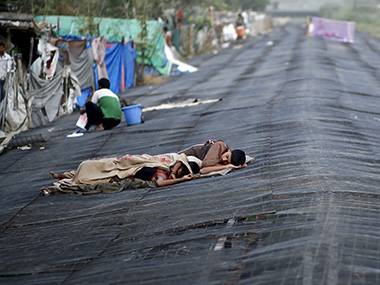More than 2000 have died as India’s heatwave takes a perilous turn and there is no respite from the soaring temperatures. In Andhra Pradesh and Telangana, where over 2,000 people have died because of exposure to extreme heat, National Regional Employment Government Scheme (NREGS) workers have emerged as the most vulnerable — 40% of sunstroke victims are those enrolled in the central government scheme according to the Times of India. The remaining 60% are mostly migrant workers, construction and other manual labourers, and the urban homeless. [caption id=“attachment_2272384” align=“alignleft” width=“380”]  Reuters.[/caption] Parts of India have had temperature highs of 47 to 49 degrees celsius which push the capabilities of the human body way beyond the limits of it’s cooling systems and most of the working hours are spent outdoors, mainly in agriculture. A heat wave can be deadly as it kills inducing heatstroke, which damages the brain, the kidneys, and other organs.It also increases the chances of succumbing to a heart condition, a stroke, or breathing problems. Problems in the functioning of the human body start when your body can’t keep its core temperature close to 98.6 degrees. This problem is exacerbated by the fact that humidity in the areas most affected by climate change poses an insurmountable challenge to the way the human body deals with heat, reports the Guardian. A recent study published in Nature Climate Change estimates that heat stress has already reduced global labour to 90% of capacity during the hottest months of the year. Under the most dire climate change projections, this could fall as low as 40% by 2200. The regions predicted to be worst affected include India, northern Australia and the south-east of the US.
According to the Slate explainer, when your central temperature rises a couple of degrees above normals is your nervous system immediately starts working to cool the body down. It starts trying to divert blood away from your internal organs and toward your skin. Since blood carries a lot of heat, cooling requires the body to start pumping it to the surface. While, your sweat glands start to release water, which has a cooling effect as it evaporates from the surface of the skin. During hotter days, the body is not be able to radiate any heat from the surface of the skin, and sweat doesn’t evaporate fast enough to keep you cool. Dehydration makes it much worse and the heart responds to the increased temperatures by pumping more blood away from the internal organs. This deprives the intestines of oxygen, which damages their linings and makes them more permeable to endotoxins. The strain on the heart in some cases also leads to arrhythmia or cardiac arrest. The brain and central nervous system are the most sensitive to high internal temperatures, and it causes confusion, strange behaviors, loss of memory and an inability to think clearly. According to Chris Minson, an environmental physiologist at the University of Oregon, the human body can tolerate high temperatures quite well. In his experiments, people have withstood temperatures as high as 215 F for as long as 30 minutes. Athletes are the best example as with training they compete in long-distance running and biking races in desert conditions without dangerously overheating.
People with pre-existing health conditions face extra challenges. The heart has to work harder in the heat, increasing the risk for heart attacks in people with cardiovascular problems. For people with diabetes, kidney diseases and other conditions, regulating temperature and fluid levels can be particularly difficult, leading to dehydration, kidney failure, liver problems and worse.


)

)
)
)
)
)
)
)
)



